
| THE INDUSTRIAL RAILWAY RECORD |
© APRIL 1975 |
STEAM ON THE PENYDARREN
M.J.T. Lewis
1. THE PENYDARREN TRAMROAD
The Penydarren Tramroad is famous as the line on which Trevithick's locomotive ran in 1804, the first engine to pull a load on a railway. But the tramroad and the system of which it formed the major part had two other important and interesting features which are less well known: the permanent way of the first railway in the area and the series of early industrial locomotives (most of them Welsh-built by Neath Abbey Ironworks) that traversed the line in the 1830s and 1840s. Much nonsense and many inaccuracies have been written in the past about the Penydarren and its ancillary tramroads; indeed the history of these lines is complicated, confusing and at times conjectural. I hope, however, that this account is an improvement on what has gone before, but I lay no claim to great expertise on the area, which deserves (and is receiving from others) the benefit of much deeper research. This section, therefore, attempts merely to set the scene so that the locomotives, which are primary object of this article, can be viewed against the proper background.
There were three ironworks to the east of Merthyr Tydfil. Dowlais (begun in 1759) grew rapidly in the early 19th century until in 1845 it was the largest ironworks in the world, employing a workforce of 10,000. The others were smaller: Penydarren works (1784), adjoining Dowlais on the south and west, and Plymouth (1763), to the south of Penydarren, which established several offshoots nearby in 1803 a forge and later a rolling mill at Pentrebach, and in 1819 a group of furnaces at Dyffryn. Neither Plymouth nor Penydarren developed nearly as fast as Dowlais. All three companies, sooner or later, mined or quarried their own ore, coal and limestone, and all had their own railway systems leading between the various branches of their undertakings. All three produced primarily pig iron, but converted an ever increasing proportion of it to wrought iron, and as Railway Age got under way they came to concentrate on rolling rails. The fourth major ironworks at Merthyr, the Crawshays' Cyfarthfa works, hardly comes into this story.
The major industrial development of South Wales began in the 1780s and especially the 1790s. In Taff Vale and some of the other valleys the main commodity involved was not coal the real growth in that trade only came later but iron. Resources were plentiful and demand good; only transport was lacking. It was the canals that began to open up the country, with a series of roughly parallel routes up the valleys, dating mostly from the 1790s. The terrain often prevented these canals from actually reaching the industry, so that feeder railways proliferated. The Glamorganshire Canal is a case in point, being opened from Merthyr down to Pontypridd in 1792 and to Cardiff in 1794. It served Cyfarthfa directly, and even before the canal was open Dowlais laid a two-mile railway to carry its iron down to a basin at Merthyr. This line was complete by June 1791, and cost about £3,000 of which the Canal Company, wishing to attract traffic, paid £1,000. The gradient was horrific an average of about 1 in 23, with a maximum of 1 in 16½ and horses worked the waggons in both directions.
Up to this time, all railways had basically wooden track. In the north, a gauge in the 4ft to 5ft range and waggons holding up to 3 tons were the norm, with the wooden rails occasionally protected against wear a tear by thin wrought iron plates. The West Midlands and Wales, however, followed the example set by the Shropshire collieries and ironworks, which favoured narrower gauges (up to 3ft 6in or so), smaller waggons and sometimes flat cast iron plates laid on top of the wooden rails. This form of protection and it was no more than protection had been introduced at Coalbrookdale in 1767, but its logical development, the rail made solely of cast iron, only appeared in 1791. This happened in South Wales, an area that always looked towards Shropshire in mining, ironmaking and transport, and the line involved was the Dowlais-Merthyr railway. William Taitt of Dowlais wrote on 17th March 1791: "We are now making Rails for our own Waggon way which weigh 44 li or 45 li [Ib] per yard. The Rails are 6 feet long, 3 pin holes in them, mitred at the ends, 3 Inches broad Bottom, 2½ In. top & near 2 In. thick thus:"


These were, as far as is known, the first all-iron rails ever made for flanged wheels to run on. They were spiked down to wooden cross-sleepers in the time-honoured way. The design was closely copied in the next few years on a number of feeder railways to the Monmouthshire and Brecon & Abergavenny Canals. The gauge of these lines was 3ft 4in, and as they were engineered, like the Glamorganshire Canal and the Dowlais railway, by the Dadford family, it is likely that the Dowlais gauge was similar.
This railway was intended to serve Dowlais alone. In March 1791 Samuel Homfray of Penydarren expostulated to William Taitt about the chosen route, which passed near Penydarren but not close enough to serve his works directly. In reply, he received a stinging rebuke. "We shall ... without consulting the Opinion of any one, make the road in such way as we think proper for our own Convenience ... If you want an Accomodation from us, ask it as a favor, but do not think of demanding it as a right ... Mr Dadford recommended the opposite side of the Brook to your Works as the most Eligible way to take the road. This concurring with our own ideas determined us". The result, it seems, was that Penydarren built their own railway to the canal, closely paralleling the Dowlais line and in places right alongside it. The date was somewhere in the 1790s, but the original type of rail and gauge are quite unknown. This railway, though not the Dowlais one, had a short tunnel under Bethesda Street in Merthyr.
The limestone for our three ironworks was obtained from quarries to the north of Merthyr. Plymouth's limestone, for a long time, came from the Crawshays' Gurnos quarry. Richard Hill, the Plymouth ironmaster, had to pay Crawshay through the nose for the supply of stone; he seems also to have built in 1792 at least part of the railway from Gurnos to Cyfarthfa furnaces and the head of the canal, and he had to carry the stone to Merthyr, probably by canal to Abercanaid wharf and perhaps by railway from there to Plymouth furnaces. Further north-east, Penydarren owned the western part of Morlais quarries and Dowlais the eastern part, and both no doubt began by carrying the limestone to their respective works by cart. To ease the transport position, however, Dowlais built its second railway, from the quarry to the works, probably in 1792; its course is very dubious, but (as marked on the map) it may have followed the approximate route later taken by the Brecon & Merthyr from Pantyscallog to Dowlais Central. The gauge and rail were presumably the same as those on the Dowlais-canal railway. Whether Penydarren had its own railway from Morlais in the 1790s we do not know.
Dowlais' third early railway again dated from the 1790s: "In the principal colliery which supplied the Dowlais blast furnaces there was a railroad, over which each horse worked with one wagon" a poor performance, but "the defect arose more from the neglected state it was suffered to be kept in, than from any imperfection in principle". This colliery lay probably to the east or south-east of Dowlais works.
In the late 1790s a mania for the new-fangled plateway swept over Wales. In contrast to the old-established edge railway with flanged wheels, plateway rails were flanged or L‑shaped and the wheels were plain. Practically always the rail ends were set on separate stone block sleepers instead of on transverse wooden ones. In early days the rails were simply spiked down, through notches at their ends, into wooden plugs in the blocks; later, chairs were introduced and even cast iron cross-ties which, though not spiked down, were held on the blocks by the weight of ballast, the rails being fixed in dovetailed sockets. One of the principal protagonists of the plateway in South Wales was George Overton, a mining engineer who carried out an early survey for the Stockton & Darlington, who built quite a number of local tramroads, and who largely created the ultimate shape of the Penydarren Tramroad and its connections.
The Penydarren Tramroad itself owed its origin to a quarrel between Richard Crawshay of Cyfarthfa and the ironmasters of Dowlais, Penydarren and Plymouth. Crawshay had a controlling interest in the Glamorganshire Canal Company and claimed preferential treatment in the matter of carriage, to the detriment of the other Merthyr works. The three ironmasters determined to free themselves, in whole or in part, from dependence on the canal, and they petitioned a Bill in Parliament in 1799 for a tramroad from Cardiff with branches to Merthyr, Abernant and the head of the Rhymney valley. It was defeated by canal opposition, but already, on 18th January 1799, Samuel Homfray of Penydarren, William Taitt of Dowlais and Richard Hill of Plymouth had agreed to build the section from Merthyr to Abercynon: by‑passing, that is, the upper and most inconvenient stretch of the canal. The tramroad was built without an Act; compulsory powers, though not invoked, were already provided by the Glamorganshire Canal Act, which authorised proprietors of works within four miles of the canal to build railways to it. Dowlais and Penydarren each owned five shares in the tramroad, Plymouth four. The line was built under the general supervision of Richard Hill; George Overton was the engineer; and, tradition says, the plates were "laid by an engineer named Curl".* Work began in 1800, and the tramroad was completed in 1802, being 9½ miles long from a junction with the Dowlais-canal line in Merthyr to the canal basin at Abercynon. The gauge was 4ft 2in inside the plate flanges, or 4ft 4in over them.
* One wonders if this is a distorted memory of the origin of plate rails, invented by John Curr at Sheffield in 1787.
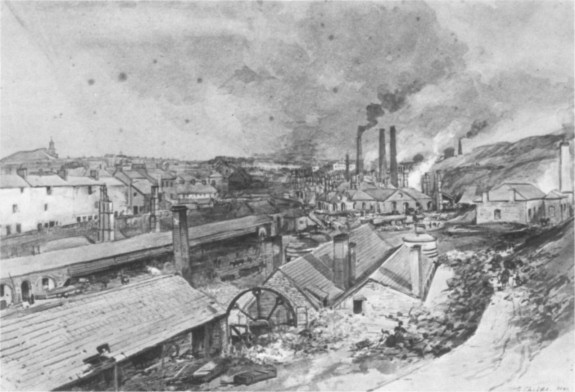
Dowlais Ironworks in 1840. Watercolour by G. Childs [British Steel Corporation]
At about the same time there were considerable changes to the private Penydarren and Dowlais systems. The Dowlais-canal line, above the new junction with the Penydarren Tramroad at Merthyr (where the Trevithick Memorial now stands) was converted to 4ft 4in plateway, so that through running from Dowlais to Abercynon was possible; the lower part, from the junction to the canal at Merthyr, was apparently closed. The Penydarren Company's line to the canal remained, consisting now of plate rails at 3ft outside gauge the standard Penydarren Company gauge.
About 1800 a new tramroad was built from the western Morlais quarries via Goetre Pond to Penydarren works, as part of the general agreement to make the Penydarren Tramroad. It was narrow gauge, but the only direct evidence for the exact figure is Mercer's measurement of 2ft 9½in between the holes in the stone blocks, which should give about 2ft 8in over the flanges. This is the Dowlais gauge; but since the line was intended for Penydarren limestone, not for Dowlais at all, a 3ft gauge seems more likely. Even stone blocks can shift. In 1803 the three ironmasters agreed to add 4ft 4in track to this Morlais-Penydarren tramroad, "the present Road to remain on the inside of the Wide Road", and the stone blocks once visible indicated three-rail track. The purpose of this dualling of the gauge was to permit through running via the Penydarren Tramroad to Plymouth works, and thus to free Hill from his bondage to Crawshay in the matter of limestone. The Morlais line became a part of the "General Road", paid for initially according to the shares each ironworks held, and maintained thereafter according to the tonnage carried by each.
Also about 1800 Overton converted the Morlais-Dowlais railway into a plateway. It was, in his own words, "of the same description with that which is used under ground, not more than two feet and a half wide [inside the flanges, or 2ft 8in over them the Dowlais standard gauge] ... Upon this road each horse hauled regularly a weight of nine or ten tons, and took the empty carriages back". A far better performance, he claimed, than was possible on an edge railway.
He also converted the edge railway from Dowlais colliery to the furnaces in the same way, with the result that, whereas before a horse had managed only one waggon, now "each horse regularly hauled from the farthermost part of the colliery twelve trams, carrying fifteen hundred-weight each, and took the empty ones back". As was usual in such cases, the exact route of this line was frequently altered as new pits were opened and old ones closed. Penydarren also had its own coal lines, which included inclines, on the 3ft gauge and going in the same general direction as the Dowlais ones.
The Penydarren Tramroad (also known, with greater accuracy, as the Merthyr Tramroad) clung to the hillside on the east side of the Taff for almost all the way, with the gentle average gradient of 1 in 145. Apart from the occasional road bridge and culvert, it had only three engineering features of note. At Plymouth works, the line passed right underneath the charging area of the furnaces in a tunnel 8ft high and 8ft wide: ample clearance for horse-drawn trams but a distinct impediment to locomotive working. Two bridges carried the line across a large loop of the Taff near Quakers Yard, both of which began life as timber structures. On 16th February 1815 Josiah Guest of Dowlais reported to William Taitt: "The upper Tram Road Bridge near Quakers Yard fell down yesterday while the Penydarren Trams were going over it. The whole of the Iron, Trams, Horses & Hallier fell into the River as well as 4 other Persons who were riding on the Trams. One horse was killed & another much cut. The Hallier & another Person were hurt very much, the others escaped slightly bruised. William Richards is gone down to see what can be done to replace it. In the mean Time we shall send our Iron down, unloading it at Penydarran to their narrow Road [the 3ft line to the canal at Merthyr] & put a parting to turn into our yard. I expect to load two Boats tomorrow". Two days later he wrote: "The Fall of the Tram Road Bridge was owing to the decay of the Timber which had been observed to be in a bad State sometime. I have consulted Mr Hill & Mr Scale & we think to rebuild it either of Oak or Iron. The lower Bridge is also in a very dangerous State & must be repaired this Summer." In the event, both bridges were replaced by large elliptical stone arches, each of 63ft span, with the deck about 32ft above the water. Both survive as outstanding examples of the early railway bridge.
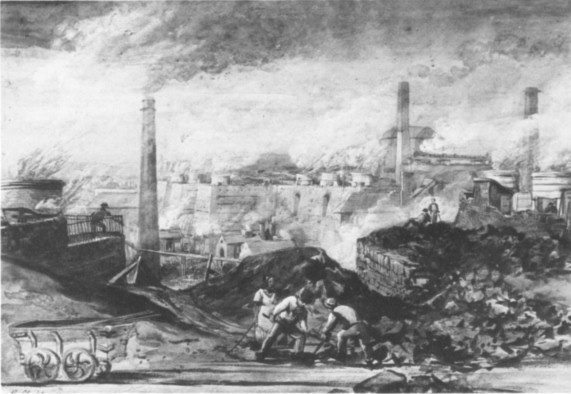
Dowlais furnace tops and tram, 1840. Watercolour by G. Childs [British Steel Corporation]
The Penydarren was a single-track tramroad with frequent passing loops. The original track consisted of 3ft‑long cast iron plate rails with upward-bellied flanges and a strengthening rib below; they weighed about 60 lb each and were spiked directly to rough stone blocks about 1ft 6in square. Later, chairs were introduced to provide a better bearing surface and a new pattern of rail that instead of a spike-notch had a downward projection to prevent longitudinal movement. These rails were keyed in the chairs. A third type of rail was a dual-purpose one, with both notch and projection. All this ironware was doubtless cast at the three ironworks interested in the line. Many blocks are still in position from Mount Pleasant southwards, and some rails may be seen in the Cyfarthfa Museum at Merthyr. As we shall see, when locomotives were introduced the continual breakage of plates under their weight created a serious problem, but cast iron rails were retained to the end.
The trams or waggons were about 7ft 6in long by 4ft 9in wide at the top, each side consisting of a vertical plank 1ft high topped by a flared plank 9in high. The bodies were originally of timber strapped with iron, though later 1/8in plate iron was adopted. The cast iron wheels were usually 2ft 6in to 2ft 9in in diameter, with a tread 1Ύ in wide. A tram's capacity was two tons or a little more, and its weight was 15cwt. By 1830 there were 250 of them. In the early days, one horse normally pulled five trams (10 tons of iron) down and the empties back up, making one return trip a day; but before long bigger trains became normal, often with three horses hauling about 25 trams (50 tons of iron). Although the line was privately built, other parties were allowed to carry goods on it on payment of a toll; but it is not known if this ever happened. Passenger traffic, though quite unofficial, was winked at: anyone who was ready to tip the driver and to perch on a tramful of bar iron was allowed a ride.
The traffic consisted largely of iron for export from Cardiff, and grew markedly for much of the tramroad's life. In 1820 Dowlais sent down 11,115 tons of iron, Penydarren 8,690 tons and Plymouth 7,941 tons; in 1830 the respective tonnages were 27,647, 11,744 and 12,177; and in 1840 45,218, 16,130 and 12,922. From the late 1820s, however, more and more iron ore was imported, a traffic which came to outstrip the tramroad's capacity on the uphill haul, so that the bulk of it was carried by canal up to Merthyr and transferred to the Penydarren Company's line there. In 1835, for example, Dowlais alone imported 15,668 tons of ore and cinders. To deal with the increase in both traffics, locomotives were introduced. Trevithick's engine had hauled several trains to Abercynon in 1804, but it was simply an experiment which was only a partial success. Regular locomotive working began in 1832, when an engine owned by the Penydarren Company was closely followed by a series belonging to Dowlais, some of which worked the steep section up to Dowlais with the aid of a rack rail laid between the running rails. Even so, the primitive tramroad was fast becoming an anachronism, and the ironmasters were intent on improving the outlet for their iron.
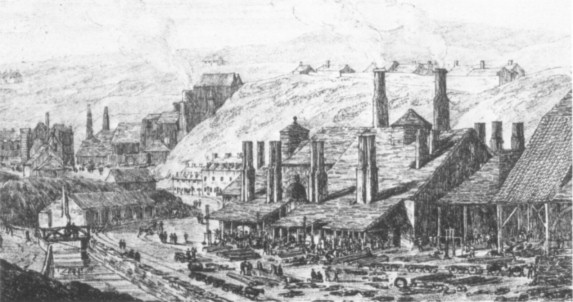
Penydarren Ironworks in 1813. [J.G. Wood, "The Principal Rivers of Wales Illustrated"]
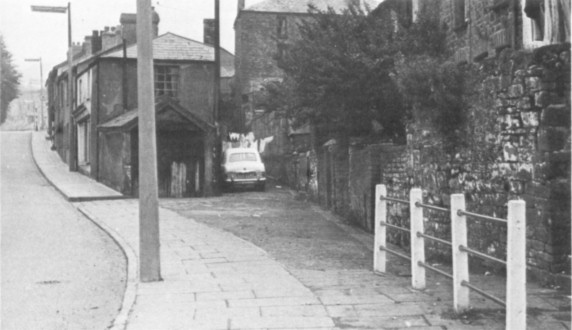
Bethesda Street, Merthyr, looking east. The car is standing on the route of the Penydarren Company's line to the canal, with Bethesda Street tunnel beyond; the Dowlais Company's line to the canal ran along the street to the left.
[P.G. Rattenbury]
As early as 1823 they promoted a Bill to extend the tramroad to Cardiff again the primary cause was a quarrel with the Glamorganshire Canal Company and again the Bill was lost. In the end, with Hill of Plymouth and Guest of Dowlais among the chief promoters, the Taff Vale Railway obtained its Act in 1836, and was opened from Cardiff to Abercynon in 1840 and to Merthyr in 1841. The Taff Vale had powers to make branches to the ironworks, but there were endless postponements and amendments to the plans. In spite of two further Acts dealing with the Dowlais branch, nothing was done until in 1849 Dowlais obtained its own Act for the standard-gauge Dowlais Railway from the works, via a long incline, to the Taff Vale at Merthyr. This was opened in 1851, at first as a public passenger railway, but later carrying the owner's goods traffic only.
The exact stages by which Dowlais converted its various lines from plateway to edge railway are obscure. As early as 1832 the firm must have seen the standard gauge on the horizon, for in that year it specified for its second plateway locomotive dual-purpose wheels ordinary flanged wheels to fit standard gauge, but with extra thick flanges of 4ft 6in gauge inside, for running on plate rails meanwhile. In 1841, in the expectation of an imminent connection to the Taff Vale, standard gauge lines began to replace plateways in and near the ironworks, although as it happened the connection was delayed for ten years. Certainly, from 1841, Dowlais sent out considerable quantities of traffic from the TVR terminus at Merthyr, but just how the iron was got there from the works is not clear; the TVR station was conveniently close to the Penydarren Tramroad. Nor is it known how long Dowlais continued to use the Penydarren Tramroad; it certainly stopped doing so in 1851 if not before, and the stretch from Dowlais to Penydarren works was presumably abandoned at the same time.

Victoria Bridge, the lower Penydarren Tramroad bridge across the Taff at Quakers Yard. The piers beyond carried a feeder to the Glamorganshire Canal. [collection T.J. Lodge]
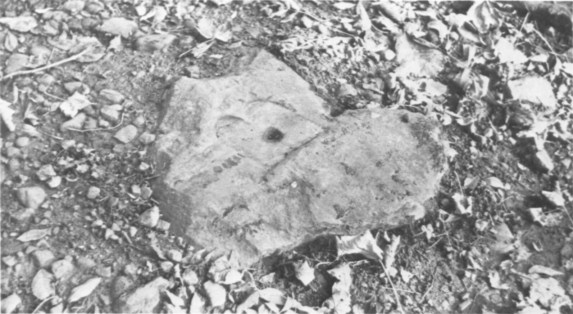
Penydarren Tramroad stone block sleeper, showing impressions of the rail ends and the single spike hole. [T.J. Lodge]
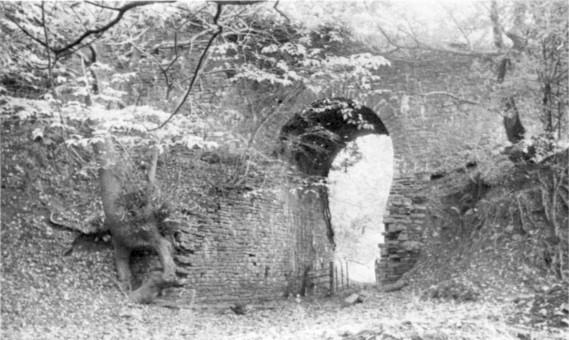
Road bridge over the Penydarren Tramroad half a mile south of Mount Pleasant. [T.J. Lodge]

Crossing of a set of points with scallop-edged channel rails for level crossings. [P.G. Rattenbury]
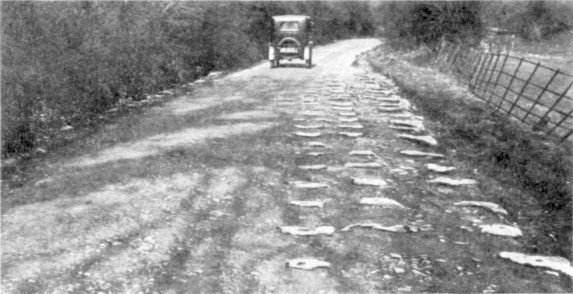
Trackbed of the Moralis-Penydarren tramroad, showing rows of stone blocks which carried the dual gauge track. [collection T.J. Lodge]
Thereafter the tramroad fell out of use piecemeal. When Penydarren works closed in 1859 the section down to Plymouth was probably closed too. Plymouth went on sending some iron down to Abercynon for a while, but ceased to produce iron in 1880, though it continued its coal mining. Already, in 1871, Plymouth had built a standard gauge mineral line that used parts of the tramroad route as far as Mount Pleasant; south of here the tramroad seems to have been lifted about 1890. Much of the route can still be followed, though in places it is buried in industrial waste, and most of the southern part has been thoroughly disturbed in recent times by the laying of a large water main.
Of the Dowlais tramroads, that from Morlais quarry seems to have been superseded somewhere around 1820 by a new line to limestone quarries at Twynau Gwynion near Pontsticill; this route was later used by the Bute Ironworks at Rhymney, but early maps show a connection to Dowlais only. Inside Dowlais works and connecting up the various coal and ironstone mines to the south-east was an extensive system of internal tramroads which had excited the interest of a foreign visitor as early as 1802‑3. It consisted after about 1800 of plateways (the rails fixed in iron cross-ties in earlier days, in heavy chairs later), some on the Penydarren Tramroad gauge of 4ft 4in, some on the Dowlais gauge of 2ft 8in. Conversion back to edge rails began in 1841 when the "Bargoed Coal Road" was rebuilt to standard gauge, with flat trucks each carrying three 2ft 8in plateway trams between pits and works. Standard gauge lines spread, and there were some edge railways of 2ft 9in gauge. In 1848 about ten miles of plateway still existed on the limestone and internal works lines, plus at least 25 miles in and around the mines themselves; but there were 15 or more miles of edge railway too. To avoid the expense of replacing all the track and all the trams in one fell swoop, wrought iron combined plate-cum-edge rails (known as "Sir John Guest rails") were laid, the standard gauge engines using the edge half and the old trams the plate half: the plateway gauge over the flanges was 4½in less than the edge gauge. By 1848 apparently only two of the six Dowlais plateway locomotives survived, and six standard gauge engines had appeared. We know only their names, not their makers: EXCAVATOR, VOLCANO, PRINCE, nameless, EOLUS and ENGLAND. EXCAVATOR (used in building the Cheltenham & Great Western Union Railway) and apparently VOLCANO were bought by Dowlais in 1844 from E. Oldham & Son, the railway contractors, for £500: the sale agreement is quoted on page 327 of RECORD 56. By 1856 another five engines had been added: a Sharp Stewart in 1851, three Neilsons in about 1854, and a Beyer Peacock in 1856.

Of the Penydarren lines, that to the canal on the 3ft gauge was for a time little used except in a crisis like that created by the Taff Bridge disaster of 1815, which entailed transhipment of Dowlais iron from broad to narrow gauge. It was possibly converted to 4ft 4in gauge around 1827 to cater for the new traffic coming up from Merthyr canal basin, a change perhaps confirmed by Mercer's implication that 4ft 4in cross-ties have been found on its route. There would have been no use for the line after the closure of Penydarren works in 1859. The tramroad from Morlais remained with mixed 4ft 4in and (probably) 3ft gauge until it closed in 1859 or later. The coal lines also continued to a similar date. The Penydarren Company had a 3ft gauge locomotive from 1829 to 1832 which could have run on any of these routes.
Around Plymouth works the tramroad across the Taff to Abercanaid wharf on the canal was probably built as an inlet for limestone from Gurnos and an outlet for iron, and may thus be early. It may well have been closed in 1802. Thereafter, pig iron for conversion into bar was carried from Plymouth down the Penydarren Tramroad to a steep branch which led down to Pentrebach forge, though later a private line was made between the two works and bar iron was then sent out from Pentrebach up the steep branch to the Penydarren. When Dyffryn furnaces were opened in 1819, this line was extended to there, but iron was still put on to the Penydarren by taking it back to Pentrebach. This system was using cast iron cross-ties by 1822, some of it on a 2ft 2in gauge over the flanges, some on 4ft 4in. 2ft 8in gauge edge rail locomotives (Fletcher Jennings, Hawthorn's of Leith and Neath Abbey) arrived in 1864, and again combined edge-plate rails, resting in chairs, were adopted. A description of the system at this stage is summarised on page 60 of RECORD 3/4 (Volume 1). Plymouth also came to be served by a branch off the Taff Vale, with standard gauge locomotives from 1864.
A final connecting line deserves mention, a tramroad owned by Sir Christopher Smith and built by the 1820s to link collieries in Gelligaer and Llancaiach to Abercynon. Since it joined the Penydarren Tramroad there, it was presumably of the same 4ft 4in gauge, and certainly used similar, if lighter, rails.
|
Part 2 |
|